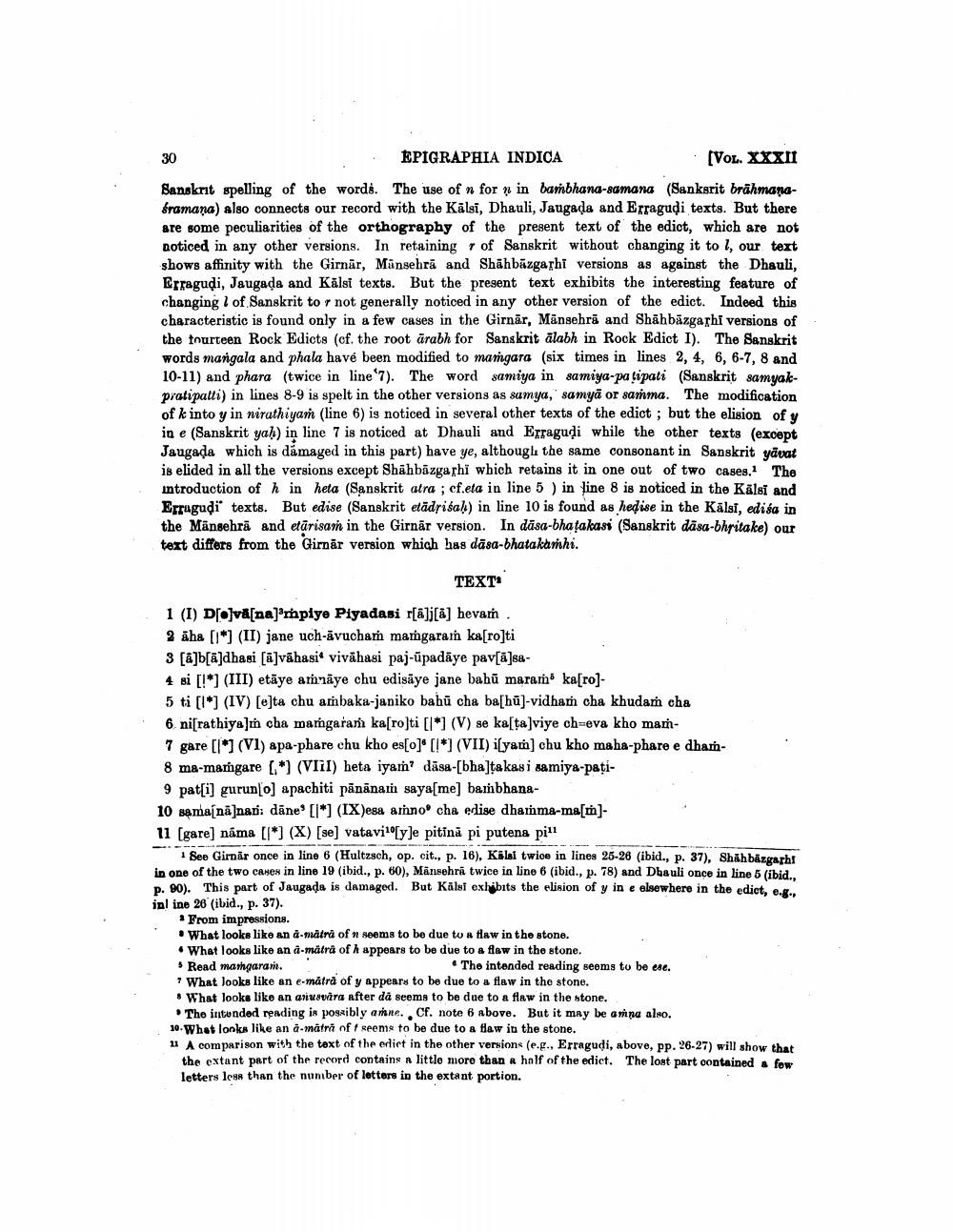________________
30 EPIGRAPHIA INDICA
• (VOL. XXXII Sanskrit spelling of the words. The use of n for in bambhana-samana (Sankarit brāhmanaframana) also connects our record with the Kālsi, Dhauli, Jaugada and Efraguļi texts. But there are some peculiarities of the orthography of the present text of the edict, which are not noticed in any other versions. In retaining of Sanskrit without changing it to I, our text shows affinity with the Gimnār, Mansehra and Shāhbāzgarhi versions as against the Dhauli, Erragudi, Jaugada and Kálsi texts. But the present text exhibits the interesting feature of changing I of Sanskrit to r not generally noticed in any other version of the edict. Indeed this characteristic is found only in a few cases in the Girnār, Mānsehrā and Shāhbāzgarhi versions of the fourteen Rock Edicts (cf. the root ārabh for Sanskrit alabh in Rock Edict I). The Sanskrit words mangala and phala have been modified to mangara (six times in lines 2, 4, 6, 6-7, 8 and 10-11) and phara (twice in line 7). The word samiya in samiya-pa tipati (Sanskrit samyakpratipatti) in lines 8-9 is spelt in the other versions as samya, samyā or samma. The modification of k into y in nirathiyam (line 6) is noticed in several other texts of the edict ; but the elision of y in e (Sanskrit yah) in line 7 is noticed at Dhauli and Efragudi while the other texts (except Jaugada which is damaged in this part) have ye, although the same consonant in Sanskrit yavat is elided in all the versions except Shāhbāzgarhi which retains it in one out of two cases. The introduction of h in heta (Sanskrit atra ; cf.eta in line 5 ) in line 8 is noticed in the Kälsi and Errugudi texts. But edise (Sanskrit etādrisal) in line 10 is found as hedise in the Kālsi, edisa in the Mänsehra and etūrisan in the Girnar version. In dāsa-bhatakasi (Sanskrit dāsa-bhritake) our text differs from the Girnār version which has dāsa-bhatakamhi.
TEXT:
1 (I) D[o]vä[najompiye Piyadasi r[a]j[a] hevam. 2 āha (1*] (II) jane uch-āvucham mangara ka[ro]ti 3 [@]b[7]dhasi (ā]vāhasi* vivāhasi paj-ūpadāye pav[ā]sa4 si [!*] (III) etāye amnāye chu edisāye jane bahū maram' ka[ro]5 ti (I*] (IV) [e]ta chu ambaka-janiko bahū cha ba[hū]-vidham cha khudam cha 6 nisrathiyam cha margaran ka[ro]ti [l*] (V) se ka[ta]viye ch=eva kho mam7 gare [1] (VI) apa-phare chu kho es[0]*[!*] (VII) isyam) chu kho maha-phare e dham8 ma-mamgare (.*) (VIII) heta iyam? dāsa-[bha)takas i samiya-pati9 pat[i] gurun(o) apachiti pānānam saya[me] bambhana10 samaínā]nari: dāne' [l*] (IX)esa anno cha edise dhamma-ma[m)11 [gare) nama [l*) (X) [se] vatavi1o[y]e pitină pi putena pill
Seo Cirnar once in line 6 (Hultzsch, op. cit., p. 16), Kilai twioe in linea 25-26 (ibid., p. 37), Shahbazgarh in one of the two cases in line 19 (ibid., p. 60), Mansehra twice in line 6 (ibid., p. 78) and Dhauli once in line 5 (ibid.. p. 90). This part of Jaugada is damaged. But Kälsi exhibits the elision of y in e elsewhere in the edict, e... inline 26 (ibid., p. 37).
From impressions. • What looks like an a-matra of n seems to be due to a flaw in the stone. • What looks like an a-matrå of h appears to be due to a flaw in the stone. * Read mangaran.
• The intended reading seems to be ese. 7 What looks like an e-matra of y appears to be due to a flaw in the stone. # What looks like an anusvira After då seems to be due to a flaw in the stone.
The intended reading is possibly amne.. Cf. note 6 above. But it may be anna also, 10. What lonks like an a-matra nft seems to be due to a flaw is the stone. 11 A comparison with the text of the edict in the other versions (e.&., Erragudi, above, pp. 26-27) will show that
the extant part of the record contains a little more than a half of the edict. The lost part oontained a fow letters less than the number of letters in the extant portion.




